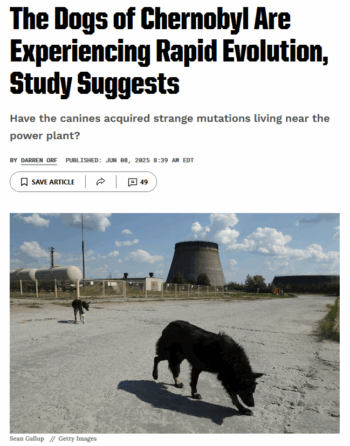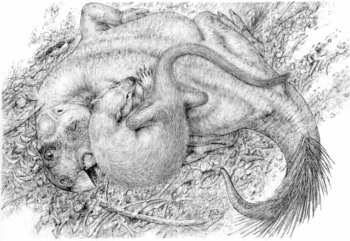
“Have the canines acquired strange mutations living near the power plant?” Popular Mechanics (6/8/25) asks. Spoiler alert: No.
I like to read science stories, even (maybe especially) when they’re not politically earthshaking. But sometimes what’s on the label is not what’s in the tin.
Take a Popular Mechanics story, “The Dogs of Chernobyl Are Experiencing Rapid Evolution, Study Suggests” (6/8/25). The subhead asks the question, “Have the canines acquired strange mutations living near the power plant?”
To answer that, PM reports on a paper from 2023: “The study uncovered that the feral dogs living near the Chernobyl Power Plant showed distinct genetic differences from dogs living only some 10 miles away in nearby Chernobyl City.” That is literally all we learn about the findings of the study that the headline is based on.
It does go on to say that a newer study finds that the answer to the subhead’s question is “no”:
A study published nearly two years later confidently asserts that we can cross radiation off the list of explanations for the current state of the Chernobyl canine population…. This new genetic analysis looked at the chromosomal level, the genome level and even the nucleotides of the Chernobyl dogs, and found no abnormalities indicative of radiation-induced mutation.
Oh. Never mind!
I guess an accurate headline—”Study Finds No Sign Chernobyl’s Dogs Are Radioactive Mutants”—wouldn’t have gotten as many clicks.

“Dinosaurs didn’t rule the Earth,” Big Think (6/10/26) argues, because someone found a fossil of “a badger-like mammal…biting a small horned dinosaur.”
Another piece appeared in Big Think (6/10/26) under the headline “A Mesozoic Myth: Dinosaurs Didn’t Rule the Earth Like We Think.” Intriguing! Tell us more?
It turns that the argument is basically that even though none of them were “larger than the size of a house cat,” during the age of dinosaurs “there were ancient mammal equivalents of squirrels, shrews, otters, aardvarks, flying squirrels and more.” I put it to you, though, that none of these are the kind of creatures that we think of today as “ruling the Earth.”
This content originally appeared on FAIR and was authored by Jim Naureckas.